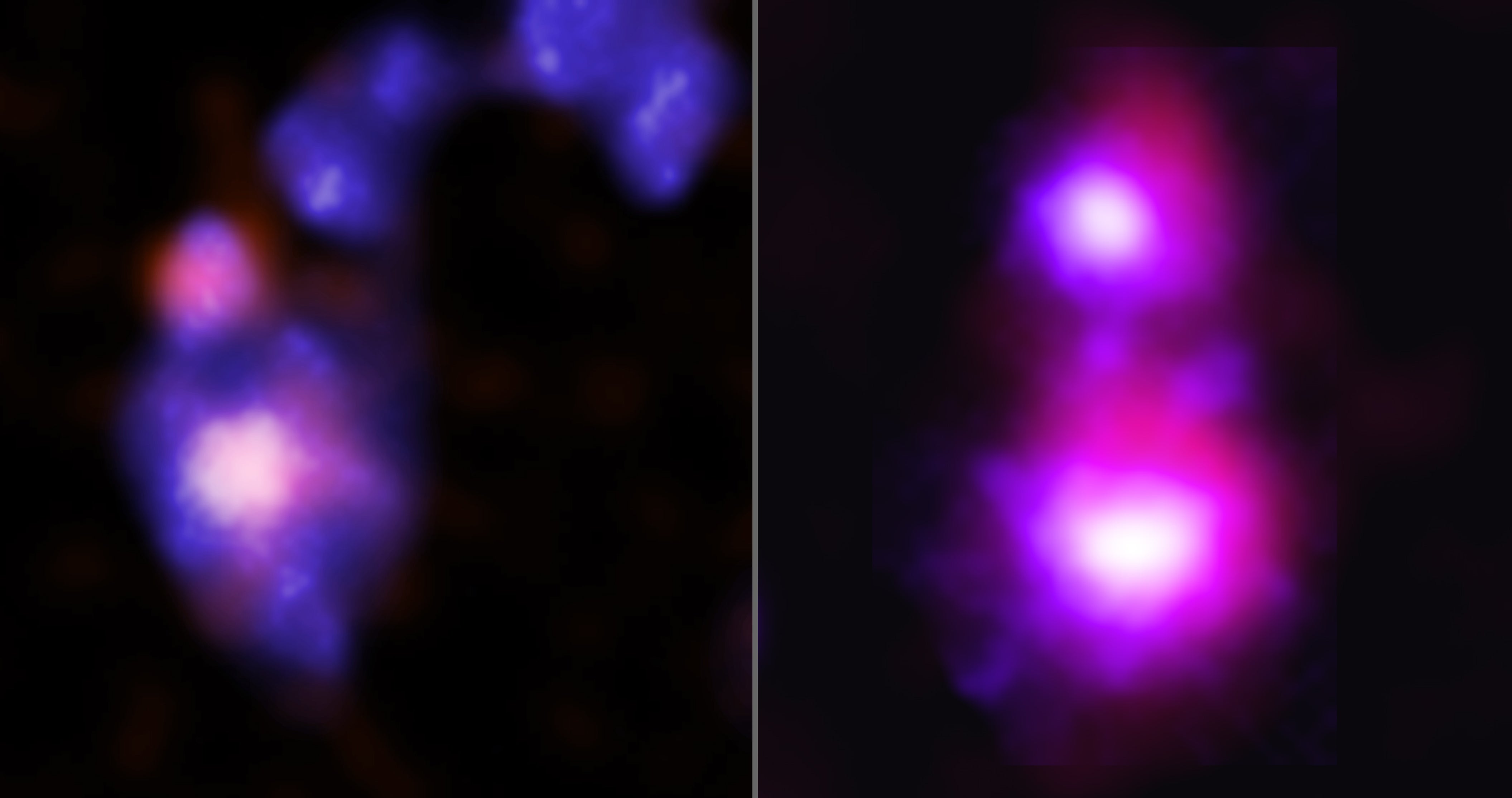
For the first time, astronomers think they’ve spotted two pairs of merging dwarf galaxies, with each pair sporting a duo of soon-to-collide black holes. The observations could reveal new details about the early formation of large galaxies like our own Milky Way, as well as the supermassive black holes that lurk at their centers.
Despite their relatively small size, dwarf galaxies pack a hefty scientific punch. Thought to be the most abundant galaxy type during the first several hundred million years after the big bang, when the expanding universe was smaller and denser than it is now, dwarf galaxies must have been progenitors of the bigger objects we see today. Across eons, large galaxies gradually assembled via countless collisions of their dwarfish kin, scientists presume. But whether these cosmic building blocks also contained sizable central black holes has been something of an open question. Now, however, astronomers believe they’ve discovered a clue. They have found evidence of bulky black holes feeding on gas and dust in what seem to be two colliding pairs of dwarf galaxies. The team described the two candidate systems in a paper published last month in the Astrophysical Journal.
Researchers have previously found examples of merging dwarf galaxies, some of which even showed signs of harboring a black hole in one of the galaxies, says lead study author Marko Mićić, a doctoral student in astronomy at the University of Alabama. But never before has anyone seen dual black holes in colliding dwarfs—the key to why the new finds are so intriguing. Each of the two systems Mićić and his colleagues have studied, he says, is “a complete analogue of events that probably happened in the very early universe.”
And perhaps best of all, one of the two pairs is relatively close in cosmic terms—a mere 760 million light-years away, making it a good target for further in-depth observations. That isn’t to say that those observations will be easy: because dwarf galaxies contain only a vanishing fraction of the stars and mass held in a typical Milky Way–sized galaxy, they’re also fainter and more difficult to study than their larger counterparts. And they don’t necessarily behave in the same way larger galaxies do.
“Dwarf galaxies usually look like little train wrecks—they’re messy and chaotic,” says Sabrina Stierwalt, a dwarf galaxy specialist at Occidental College, who was not involved in the new research. “They’re very cool laboratories.”
To spot the two intriguing mergers, Mićić and his colleagues used archival data from a trio of instruments: NASA’s Chandra X-ray Observatory, the space agency’s Wide-field Infrared Survey Explorer (WISE) space telescope, now called NEOWISE, and the Canada-France-Hawaii Telescope (CFHT), which is located in Hawaii.
Although black holes themselves are invisible, they can spark the universe’s brightest fireworks when they devour surrounding material. Infalling matter swirls around them at nearly the speed of light, heating up to emit powerful glows that shine across the cosmos in multiple wavelengths of light. Chandra saw that glow in the x-ray part of the electromagnetic spectrum, while WISE glimpsed it in infrared. Seeing twin glows for each merging dwarf pair in both Chandra and WISE data suggests—but doesn’t confirm—the presence in each of two feeding, “active” black holes, the researchers say. CFHT provided images of the dwarf galaxies themselves, revealing starry evidence of the likely intergalactic smashups, as well as optically bright blobs aligned with the x-ray and infrared glows.
The closer candidate merger appears to be in the late stages of coalescence, with one dwarf galaxy accompanied by a flamboyant, clumpy tail of stellar debris that is probably the shredded remnants of the other. That tail inspired the scientists to dub the system Mirabilis, named after Loddigesia mirabilis, a hummingbird species that boasts two long, thin tail plumes that end in a Ping-Pong paddle of feathers.
The second candidate is much farther away—about 3.2 billion light-years—and is earlier in the merging process. Because the two dwarf galaxies are more widely separated in space and still largely intact, the scientists bestowed both with names, calling one Elstir and the other Vinteuil in a nod to characters in Marcel Proust’s novel In Search of Lost Time. This merger, Mićić says, will likely take hundreds of millions of years to complete.
Mićić and his colleagues are obtaining additional observations of the two pairs, particularly in radio and ultraviolet light. Some of these follow-up observations could eliminate small-but-significant lingering uncertainties about whether the galaxies are really dwarfs rather than the twisted wreckage of giant galaxies wrenched apart by gravitational forces in the galaxy clusters they inhabit. Further scrutiny could also shore up the case for the bright glows at their cores really coming from voracious black holes and even help them calculate the masses of these hidden giants.
If the discovery pans out, Stierwalt says, it could become a crucial component for solving the greater cosmic puzzle of how exactly galaxies and black holes have emerged and coevolved across the universe’s history. “This would be an important piece of evidence that some of the processes that happen in massive galaxy mergers also happen in dwarf galaxy mergers,” she says, “like the fact that you can have a merging of black holes.”
